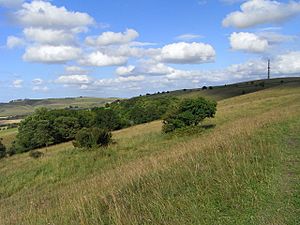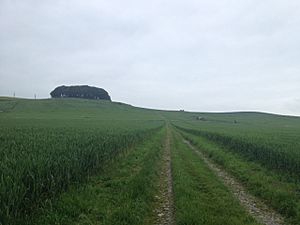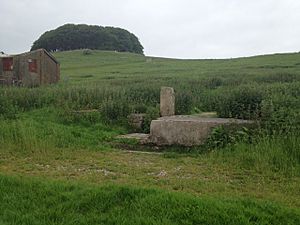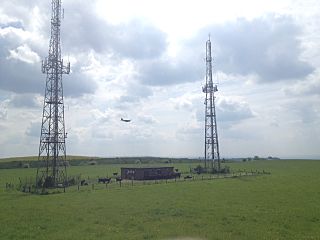Morgan's Hill facts for kids
| Site of Special Scientific Interest | |
 |
|
| Area of Search | Wiltshire |
|---|---|
| Coordinates | 51°24′12″N 1°57′41″W / 51.4034°N 1.9615°W |
| Interest | Biological |
| Area | 12.6 hectares (0.1260 km2; 0.04865 sq mi) |
| Notification | 1951 |
| Location map | Magic Map of Natural England |
Morgan's Hill is a special natural area covering about 12.6 hectares (that's like 30 football fields!). It's located between the towns of Calne and Devizes in Wiltshire, England. This spot is known as a Site of Special Scientific Interest (SSSI) because of its unique plants and wildlife. It was first recognized as an SSSI in 1951.
Contents
Where Water Flows: The Triple Divide
Morgan's Hill is a very interesting place for water. It's where rainfall can go in three different directions! This is called a "triple divide." Water falling here can end up in:
- The English Channel (via the River Avon)
- The Atlantic Ocean (via the Bristol Avon and Severn Estuary)
- The North Sea (via the Kennet and Thames)
A Special Place for Nature
This area is also a nature reserve looked after by the Wiltshire Wildlife Trust. This means it's protected so that plants and animals can thrive.
Amazing Chalk Grassland Plants
The main type of land here is called chalk grassland. This is a special kind of grassy area that grows on chalky soil. You'll find lots of a grass called upright brome (Bromus erectus).
Other cool plants that love chalky soil include:
- Chalk milkwort (Polygala calcarea)
- Horseshoe vetch (Hippocrepis comosa)
- Autumn gentian (Gentianella amarella)
Rare and Unique Flowers
Morgan's Hill is home to several rare and important plant species. These include beautiful orchids and other unique flowers:
- Round-headed rampion (Phyteuma orbiculare)
- Bastard toadflax (Thesium humifusum)
- Fly orchid (Ophrys insectifera)
- Fragrant orchid (Gymnadenia conopsea)
- Lesser butterfly orchid (Platanthera bifolia)
- Frog orchid (Coeloglossum viride)
- Musk orchid (Herminium monorchis)
- Marsh helleborine (Epipactis palustris) – this one is unusual to find on a chalky hill!
Morgan's Hill: A Hub for Communications
Early Radio Days: The Marconi Station
Long ago, in 1913, a Marconi radio station was built on Morgan's Hill. It was meant to receive radio signals from a big transmission station in Oxfordshire. However, a war started, and the station wasn't used for its original purpose.
Secret Military Messages
In 1916, the station was changed for military use by the Royal Engineers. It became an army intelligence station. Its job was to figure out where German Zeppelins (big airships) and enemy communication stations were. The plans for the station showed huge masts, about 300 feet tall and 2,700 yards long! We don't know exactly when this military station closed, but it was considered no longer needed by 1919.
Britain's First Long-Distance Ship Radio
After the war, in 1919, the General Post Office and the Marconi Company decided to turn the station into Britain's first long-range radio station for ships. It opened in 1920 and could send and receive messages up to 1,500 miles away! The equipment and staff worked out of old army huts. Sending a message cost 11 pence per word. This service was very popular, and in 1924, another mast was added.
By 1926, new short-wave radio technology was becoming popular. The Devizes station expanded again with Britain's first short-wave maritime transmitter. This was also very successful. However, there wasn't enough space on Morgan's Hill to expand further. So, a new, bigger station was opened in Portishead, Somerset, and the Devizes station closed in 1929. All the equipment was removed by 1935.
Modern Communications on the Hill
Even today, Morgan's Hill is still used for radio communications!
Police and Mobile Phone Masts
In 1981, the Wiltshire Constabulary (the local police force) put up two tall masts, each 46 meters (about 150 feet) high. They also built a small building for police radio communication equipment. This was placed near where the old stations used to be.
Later, in 1998, companies like Mercury Communications were allowed to add microwave dishes and equipment to the existing masts. This was to help with the growing number of mobile phones. Other mobile phone companies like Orange and Vodafone also added their equipment.
Today, signs on the masts show that Vodafone, Orange, and O2 mobile networks use them. Also, Airwave Communications Ltd, which handles radio for emergency services, is involved. Since 2015, it seems that a company called Arqiva owns and operates the masts.
There's also a smaller mast nearby used for land surveying, but its owner isn't known.





